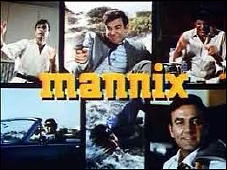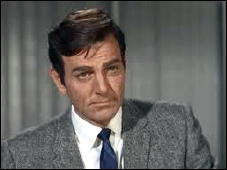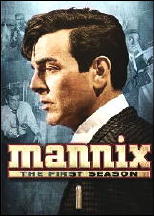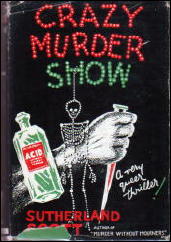Reviewed by DAVID L. VINEYARD:
FRANCES PARKINSON KEYES – Station Wagon in Spain. Farrar Straus & Cudahy, hardcover, 1959. Paperback reprints include Avon G-1054, 1960; Fawcett Crest 1066, 1967.
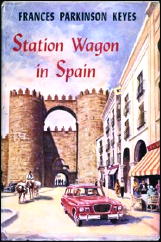
I have to confess, I struggled with Frances Parkinson Keyes (pronounced like skies). I did not want to read her books and I certainly didn’t want to like them.
From the time I started reading heavily my mother, aunt, and cousin — all female — were pushing Keyes at me, and like a mule I balked. I grew up in the South, I did not need more maudlin memories of the Civil War and fading plantations beneath drooping willow trees. I certainly didn’t need them from a conservative Republican author of New England stock and the wife of a conservative Republican senator.
Let us just say that at the time that was enough for me to lay in a stock of garlic, wooden stakes, and a crucifix to protect myself.
Resistance wasn’t easy. Copies of Keyes’ works were everywhere I went, and those three ladies were very persuasive. And Keyes didn’t help. The first time I ate at Antoine’s in New Orleans, all I could think of over the crepe and cherries jubilee was that now I’d have to read Dinner at Antoine’s. Then too, The Chess Players was about the fascinating chess master Paul Morphy who had been a Confederate spy during the Civil War. It was an obvious conspiracy.
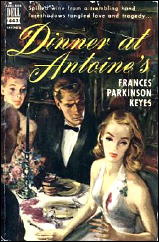
It wasn’t until a ski trip to Red River in New Mexico that fate and Mrs. Keyes caught up to me. I took a nasty spill early that morning on a patch of ice and had a bit of a concussion. The medic told me to go back to the lodge and rest — not sleep — going to sleep alone after a concussion can be the last thing you ever do — just hang around the lodge — under observation lest I slip into a coma — and rest.
Boredom and minor concern — not a good mix.
I don’t know how many of you are familiar with ski lodges, but they are singularly lonely places when the ski slopes are open. There is no television, no radio (unless you like Mariachi music or country western — it was New Mexico after all), and nothing to read. They are designed only for partying apres skiing and sleeping when you can’t party anymore.
There was no bookstore in Red River, not even a paperback kiosk at the convenience store. There may have been a library, but no one at the ski lodge knew where and with over 100 inches of snow on the ground and temperatures in the mid teens I didn’t feel like venturing out exploring. It was starting to snow too.
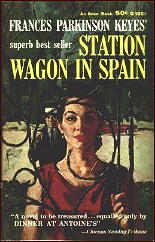
But there she was, with the only book in the entire town apparently — Frances Parkinson Keyes.
With all the resignation of a rabbit about to be eaten by a wolf I sat down to my fate.
I won’t lie to you. It was not the start of a life long love affair. I still resist Southern Plantation novels with the same passion I reserve for cold cauliflower, but grudgingly she won me over. A convert — more of less.
Between 1919 and her death in 1970, Keyes wrote a whole slew of novels, no small number of which were bestsellers. They are primarily women’s books: vivid descriptions of clothes, elegant meals, lace finery, furniture, chandeliers, and social mores mixed with a bit of melodrama and a good deal of history.
Keyes was a prodigious researcher and traveler, largely self educated and endlessly curious. She had a reporter’s eye and a pleasant gossipy style that combined to make the ideal mix for her legions of readers.

And as it turned out she was a fair to middling mystery and suspense writer.
At least two of her novels are fair play mysteries — Dinner at Antoine’s, which features a well handled change on the least likely suspect theme, and The Royal Box, about a poisoning of an American diplomat in the royal box at London’s Ellen Terry Theater. She also penned three novels of romantic suspense — Victorine, The Heritage, and Station Wagon in Spain.
Station Wagon in Spain, as you have no doubt already figured out, was the book in the lodge.
The hero of the novel, one Allan Lambert, has worked all his life and only recently come into money, and he doesn’t quite know what to do, so when he gets one of those infamous Spanish Prisoner letters (the equivalent of today’s Nigerian con) instead of laughing it off or reporting it to the Postal authorities, he buys a beat up old wood paneled station wagon and ships it to Spain to have a little fun.
This being Keyes, she not only explains what the Spanish Prisoner con was, but gives a nice little history of it dating back to the first instance in 1542 and some idea of how the Postal authorities and Spanish police deal with it.
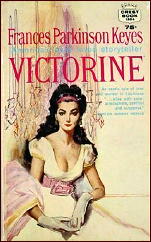
Allan soon finds himself knee deep in murder, politics, criminal gangs, romance, and ancient revenge.
Station Wagon in Spain is an exceptionally good read of its type. Nothing revolutionary, but Keyes’ novelist’s eye adds a depth to the proceedings missing in the standard model. She knows how to choreograph action,, construct a plot, and build to a pay off — in fact the book doesn’t have just one payoff, but two — three if you count the inevitable romance.
They are pretty good payoff’s too — one of them almost Poesque and damn well handled. It has a real edge and more than a touch of that passionate nature so dear to the Spanish character and history.
This isn’t the work of a mainstream novelist slumming in genre fiction.
Well, yes, it’s dated now. Her prose is a little stiff and formal. She lingers over details that her readers loved but most lovers of suspense would as soon skip, and her attitudes are those of a woman of her day, class, and social position — albeit an extremely well traveled and cosmopolitan woman of her time.
She isn’t Leslie Ford, but she’s not exactly Eleanor Roosevelt either.

And yes, I have since read a good many of Frances Parkinson Keyes novels — even some of the Southern plantation novels like River Road and Steamboat Gothic.
She was an obsessive and keen researcher, had a travel writer’s eye for the telling detail, a novelist gift for creating comfortable if not compelling characters, and despite her protests to the contrary, a real gift for suspense and mystery plotting.
If you like Helen MacInnes, Martha Albrand, Mary Stewart, Phyllis Whitney, Charlotte Armstrong, or Nora Lofts you might well enjoy her suspense and mystery novels, and if you like historical novels she was one of the masters of that form.
Her work is aimed at her primarily female audience, but there is nothing to keep a man from enjoying them with a little judicious skipping here and there — there is only so much I feel the need to know about Damascus silk, and all that sumptuous descriptions of food remind me of is that I ought to order a pizza for dinner.
I recovered from the concussion — no comments — got back on the ski slopes the next day, and when I got home rounded up all the Keyes novels my family had been pushing on me for years. I still have some of them, battered, dog eared, and once much loved.
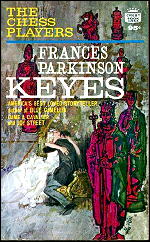
The first one I read was the Paul Morphy novel, The Chess Players.
I enjoyed it too.
If you’re in the mood for fictional comfort food, you could do much worse, and for all her flaws, her virtues still out weigh them. She is largely forgotten today, as the once popular works of past generations generally are, but there are still pleasures to be found, and you will likely feel more than a little appreciation for a time and a writer who appreciated literacy, construction, and respected her readers intelligence.
She was a most literate and accomplished lady.
As best selling writers from the past go, she is still well worth getting acquainted with.
Crime Fiction Bibliography: [Taken from the Revised Crime Fiction IV, by Allen J. Hubin]
KEYES, FRANCES PARKINSON (née Wheeler). 1885-1970.
Dinner at Antoine’s (n.) Messner 1948.
The Royal Box (n.) Messner 1954.
Victorine (n.) Messner 1958.
Station Wagon in Spain (n.) Farrar 1959.







